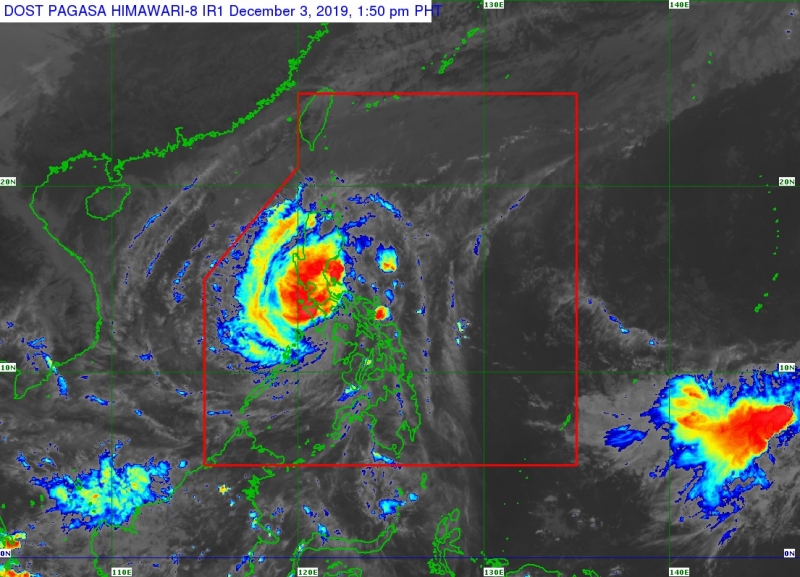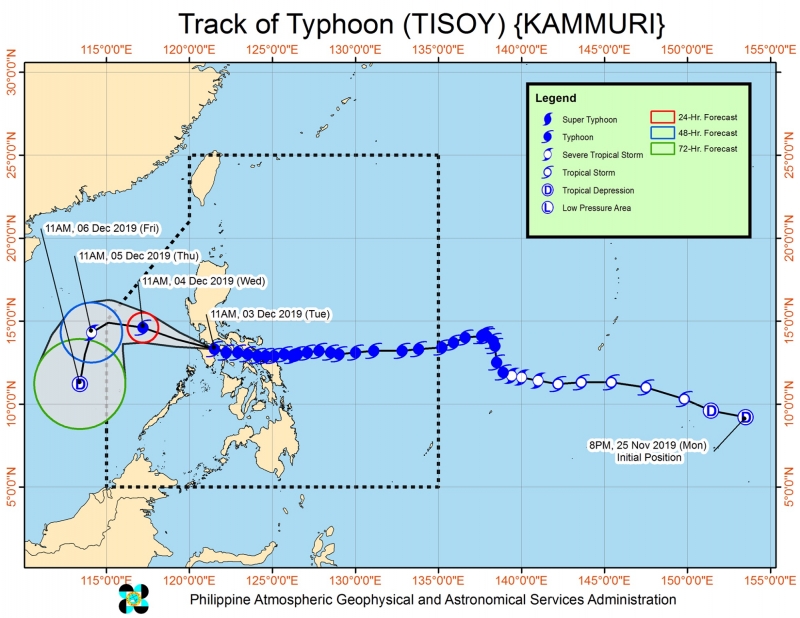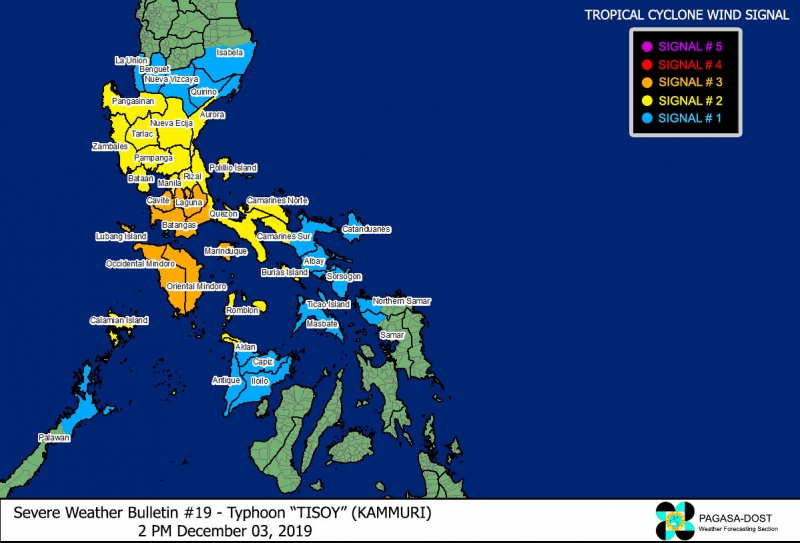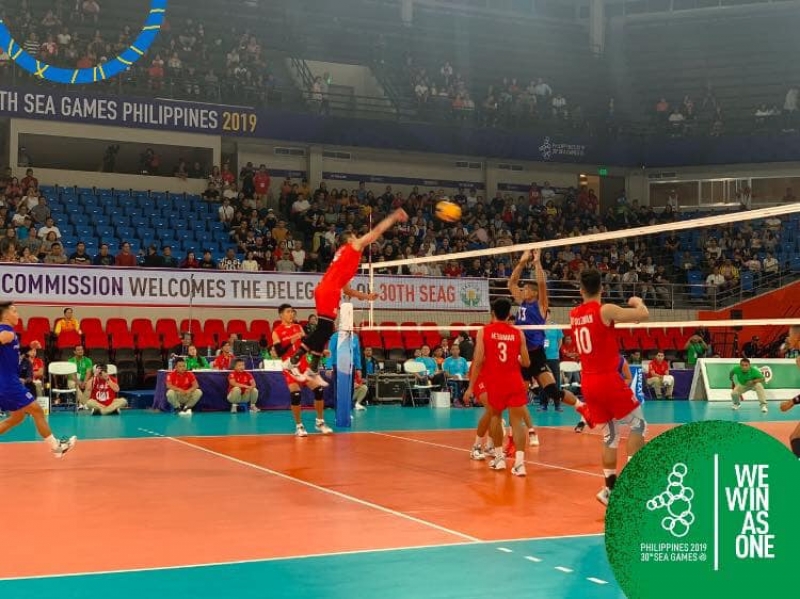Typhoon Kammuri officially made landfall in the Philippines on the evening of 2 Dec 2019. At 11pm, the typhoon (locally known as ‘Tisoy’) hit Gubat, Sorsogon — the southernmost area of the country’s Luzon region. According to the Philippine Atmospheric, Geophysical and Astronomical Services Administration (PAG-ASA), Typhoon Kammuri has sustained winds of up to 175 kilometres per hour (kph) and gustiness of up to 240kph.

Image credit: Philippine Atmospheric, Geophysical and Astronomical Services Administration Official Facebook Page
Since then, it has slightly weakened and made landfall three more times on 3 Dec, at 4am in Masbate, 8.30am in Marinduque, and later at 12.30pm in Oriental Mindoro. As of 1pm, the eye of the storm was last sighted in Baco, Oriental Mindoro, with sustained winds of up to 140kph and gustiness of up to 195 kph. According to PAG-ASA reports, the typhoon is headed west at 25kph.
Also read: 9 Useful Tips When a Natural Disaster Strikes While You’re Overseas
Affected areas around the Philippines

Image credit: Philippine Atmospheric, Geophysical and Astronomical Services Administration Official Facebook Page
Typhoon Kammuri is the 20th tropical cyclone to hit the Philippines in 2019. It is expected to hit parts of the country’s Luzon and Visayas regions, and leave the Philippine Area of Responsibility on the afternoon of 5 Dec. Afterwards, it is predicted to veer south, towards the South China Sea.
Frequent to continuous heavy rains, as well as isolated intense rains, are expected to go on from the afternoon of 3 Dec to the evening of 4 Dec. Affected areas include the Mindoro Provinces, Metro Manila, Central Luzon, Rizal, and Northern Quezon.
At the same time, occasional heavy rains are to be expected in Cagayan Valley, Cordillera Administrative Region, Marinduque, Romblon, and the rest of the CALABARZON region. PAG-ASA’s predictions also include intermittent heavy rains over the Calamian Islands.

Image credit: Philippine Atmospheric, Geophysical and Astronomical Services Administration Official Facebook Page
Tropical cyclone wind signals have been raised over the following areas:
Signal number three:
- Burias Island
- Romblon
- Southern part of Quezon
- Marinduque
- Oriental Mindoro including Lubang Island
- Batangas
- Cavite
- Laguna
Signal number two:
- Camarines Sur
- Camarines Norte
- Albay
- Catanduanes
- Sorsogon
- Metro Manila
- Bulacan
- Bataan
- Tarlac
- Pampanga
- Nueva Ecija
- Southern part of Aurora (Dipaculao, Maria Aurora, Baler, San Luis, Dingalan)
- Rizal
- Rest of Quezon including Polillo Islands, Calamian Islands, Cuyo Islands
- Zambales
- Pangasinan
- Masbate including Ticao Islands
- Northwestern part of Samar (Calbayog, Tagapul-am, Almagro, Sto. Nino)
- Aklan
- Capiz
- Northern part of Antique (Caluya, Libertad, Pandan, Sebaste, Culasi, Tibiao)
Signal number one:
- Southern part of Isabela
- Benguet
- Nueva Vizcaya
- Ilocos Sur
- Quirino
- Rest of Aurora
- Northern part of Palawan
- Rest of Antique
- Iloilo
- Guimaras
- Leyte
Cancelled flights due to Typhoon Kammuri
As a safety precaution to all travellers, the Ninoy Aquino International Airport (NAIA) has closed all of its terminals on 3 Dec, from 11am to 11pm. In effect, all flights — about 480 flights across over 20 different airlines — to and from NAIA have been cancelled.
Affected passengers are encouraged to avail of rebooking or rerouting options.
What does this mean for the 2019 SEA Games?

Image credit: 2019 SEA Games Official Facebook Page
In the face of the challenges brought about by Typhoon Kammuri, the Philippine Southeast Asian Games Organizing Committee (Phisgoc) is said to be prepared with contingency plans. Events have effectively been cancelled, moved forward, or postponed to later dates.
Outdoor events originally scheduled on 2 and 3 Dec have been cancelled or postponed. These include beach volleyball, windsurfing, surfing, skateboarding, and polo.
On the other hand, indoor sports events like basketball and volleyball will go on as scheduled. However, they will no longer be open to live public viewing as long as the weather continues to worsen.
Finally, no extensions will be made despite the cancellations and delays made due to Typhoon Kammuri. That said, the 2019 SEA Games will reportedly proceed with its closing rites on 11 Dec as planned.




